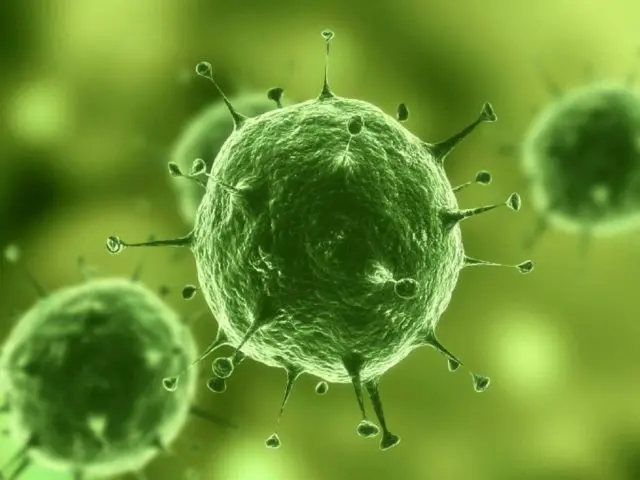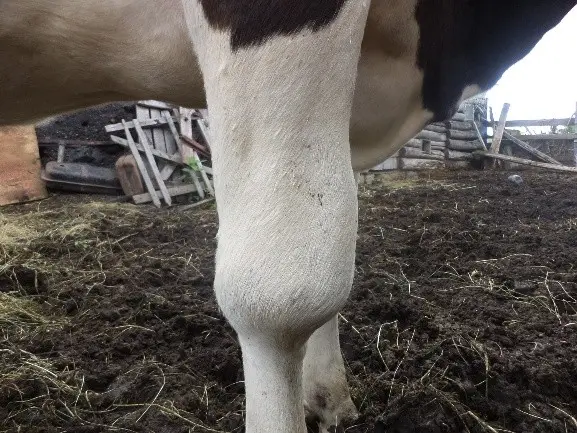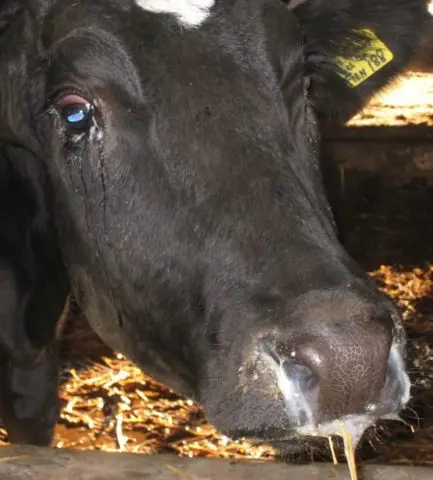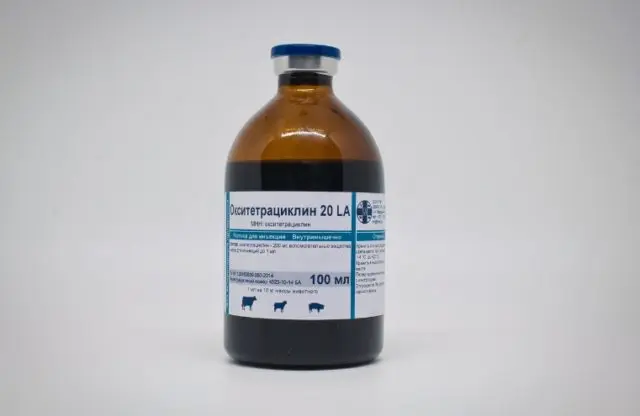Contents
Mycoplasmosis of cattle is a hard-to-diagnose and, most importantly, intractable disease that causes significant economic damage to farmers. The causative agent is widely distributed throughout the world, but due to successful “masking” the disease is often misidentified.
What is the disease “mycoplasmosis”
The causative agent of the disease is a single-celled organism that occupies an intermediate position between bacteria and viruses. Representatives of the genus Mycoplasma are capable of independent reproduction, but they do not have a cell membrane inherent in bacteria. Instead of the latter, mycoplasmas have only a plasma membrane.
Many species of mammals and birds, including humans, are susceptible to mycoplasmosis. But these single-celled, like many viruses, are specific and usually do not spread from one mammalian species to another.
Mycoplasmosis in cattle is caused by 2 varieties:
- M. bovis provokes pneumoarthritis in cattle;
- M. bovoculi causes keratoconjunctivitis in calves.
Keratoconjunctivitis is a relatively rare occurrence. Calves get sick more often. Basically, mycoplasmosis of cattle manifests itself in 3 forms:
- pneumonia;
- polyarthritis;
- ureaplasmosis (genital form).
Since the first two forms smoothly flow into one another, they are often combined under the general name of pneumoarthritis. Ureaplasmosis affects only adult cattle, since in this case the infection occurs through sexual contact.

Approximately this is what pathogens of cattle mycoplasmosis look like under an electron microscope
Reasons for infection
Calves are the most sensitive to mycoplasmas, although cattle are infected at any age. The main carriers of mycoplasmosis are sick and recovered cattle.
From diseased animals, the pathogen is released into the external environment along with physiological fluids:
- urine;
- milk;
- discharge from the nose and eyes;
- saliva, including when coughing;
- other secrets.
Mycoplasmas get on bedding, feed, water, walls, inventory, infecting the entire environment and being transmitted to healthy animals.
Also, infection with mycoplasmosis of cattle occurs in the “classical” ways:
- orally;
- airborne droplets;
- contact;
- in utero;
- sexual.
There is no pronounced seasonality in mycoplasmosis, but the greatest number of infections occurs in the autumn-winter period, when cattle are moved to farms.
The area of distribution and the intensity of infection largely depend on the conditions of keeping and feeding and the microclimate of the premises. Mycoplasmosis of cattle keeps “in one place” for a long time. This is due to the long period of preservation of bacteria in the body of recovered animals.
Symptoms of mycoplasmosis in cows
The incubation period lasts 7-26 days. Most often, the symptoms of mycoplasmosis are observed in calves weighing 130-270 kg, but clinical signs may also appear in adult animals. A clear manifestation of mycoplasmosis occurs only 3-4 weeks after infection. The disease spreads most rapidly in cold, damp weather and when cattle are overcrowded. The initial symptoms of mycoplasmosis are very similar to pneumonia:
- difficulty breathing: the cattle makes every effort to draw air into the lungs and then push it out;
- frequent sharp cough, which can turn into a chronic form;
- nasal discharge;
- sometimes conjunctivitis;
- loss of appetite;
- gradual exhaustion;
- temperature 40 ° C, especially if a secondary infection is “addicted” to mycoplasmosis;
- during the transition of the disease to the chronic stage, the temperature is only slightly higher than normal.
Arthritis begins a week after the onset of pneumonia. With arthritis in cattle, one or more joints swell. The case begins 3-6 weeks after the onset of clinical signs.

Arthritis in cattle – a “normal” phenomenon in mycoplasmosis
With the genital form of mycoplasmosis in cattle, abundant purulent discharge from the vagina is observed. The mucous membrane of the vulva is completely covered with small red nodules. A sick cow is no longer fertilized. There may also be inflammation of the udder. In bulls, palpation determines the swelling of the epididymis and spermatic cord.
Diagnosis of mycoplasmosis in cattle
Due to the similarity of the symptoms of mycoplasmosis with other diseases of cattle, the diagnosis can only be made by a complex method. When determining the disease, take into account:
- Clinical signs;
- epizootological data;
- pathological changes;
- results of laboratory researches.
The main emphasis is on pathological changes and laboratory studies.
Pathological changes
Changes depend on the area of the main defeat by mycoplasmas. When infected by airborne droplets and contact, the mucous membranes of the eyes, mouth and nasal cavity are primarily affected.
With eye disease, clouding of the cornea and its roughness are noted. The conjunctiva is edematous and reddened. As a result of the autopsy, most often, in parallel with eye damage, hyperemia of the mucous membrane of the nasal passages is detected. Lesions in the middle and main lobes of the lungs are found in the latent or initial course of the disease. The foci are dense, gray or red-gray in color. Connective tissue gray-white. Mucopurulent exudate in the bronchi. Bronchial walls thickened, gray. Lymph nodes in the area of infection may be enlarged. When mycoplasmosis is complicated by a secondary infection, necrotic foci are found in the lungs.
The spleen is swollen. The kidneys are slightly enlarged, there may be hemorrhages in the renal tissue. Dystrophic changes in the liver and kidneys.
In the case of penetration of mycoplasmas into the udder, the consistency of its tissues is dense, the connective interlobular tissue is overgrown. Abscesses may develop.
With mycoplasmosis of the genital organs in cows, the following is observed:
- swollen uterine mucosa;
- thickening of the fallopian tubes;
- serous or serous-purulent masses in the lumen of the oviducts;
- catarrhal-purulent salpingitis and endometritis.
Bulls develop epididymitis and vesiculitis.

Discharge from the eyes and nose must be sent to the laboratory for analysis
Laboratory research
For samples sent to the laboratory:
- swabs from the cow’s vagina;
- sperm;
- embryonic membranes;
- milk;
- pieces of lungs, liver and spleen;
- bronchial lymph nodes;
- pieces of the brain
- aborted or stillborn fetuses;
- affected joints in general condition;
- swabs and mucus from the nose, subject to damage to the upper respiratory tract.
Tissue samples are delivered to the laboratory either frozen or chilled.
For lifetime diagnostics, 2 blood serum samples are sent to the laboratory: the 1st when clinical signs appear, the 2nd after 14-20 days.
Treatment of mycoplasmosis in cattle
Most antibiotics kill bacteria by attacking the cell wall. The latter is absent in mycoplasmas, so there is no specific treatment. For the treatment of mycoplasmosis in cattle, a complex system is used:
- antibiotics;
- vitamins;
- immunostimulants;
- expectorants.
The use of antibiotics for mycoplasmosis of cattle is due to the desire to stop the complication of the disease by a secondary infection. Therefore, either broad-spectrum drugs or narrowly targeted ones are used: they affect microorganisms only in the gastrointestinal tract, lungs or genital organs.
In the treatment of mycoplasmosis in cattle, the following are used:
- Levomycetin (the main area of influence is the gastrointestinal tract);
- enroflon (broad-spectrum veterinary drug);
- antibiotics of the tetracycline group (used in the treatment of respiratory and genitourinary systems and eye diseases).
The dose and type of antibiotic is prescribed by the veterinarian, as there are other drugs for mycoplasmosis that are not intended for the treatment of herbivorous cattle. The veterinarian also indicates the method of administration of a particular substance, but a brief instruction is usually also on the package.

One of the antibiotics of the tetracycline group, which can be used in the treatment of bovine mycoplasmosis
Preventive measures
Prevention of mycoplasmosis begins with standard veterinary rules:
- do not move animals from farms that are unfavorable for mycoplasmosis;
- to inseminate cows only with healthy sperm;
- do not introduce new individuals into the herd of cattle without a monthly quarantine;
- regularly carry out disinsection, disinfection and deratization of premises where livestock is kept;
- regularly disinfect equipment and inventory on the farm;
- provide cattle with optimal living conditions and diet.
When mycoplasmosis is detected, milk from sick cows is subjected to heat treatment. Only then is it usable. Sick animals are immediately isolated and treated. The animals of the rest of the herd are being monitored. Premises and equipment are disinfected with solutions of formalin, iodoform or chlorine.
Vaccinations are not carried out due to the lack of a vaccine against mycoplasmosis for cattle. So far, such a drug has been developed only for poultry.
Conclusion
Mycoplasmosis of cattle is a disease that requires constant monitoring by the owner of the animals. The very case when it is better to once again take a simple clogging of the eyes for mycoplasmosis than to start the disease. The higher the concentration of the pathogen in the body, the harder it will be to cure the animal.









